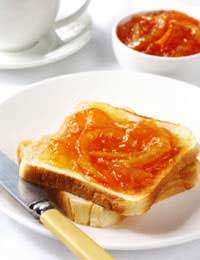
Make your own marmalade to enjoy and give away this year. This home-made preserve is rewarding and delicious – perfect for breakfast toast and teatime cakes. It’s traditionally made from Seville oranges, which are available in December and January. Buy a big pile of oranges, try our recipe and prepare a batch of marmalade to give to lucky friends all year long…
Jam-making Essentials
You’ll need a large, stainless steel preserving pan (a large pressure-cooker or other big pan is fine), a wooden spoon, a couple of saucers for testing, a sieve, some muslin, a funnel, and sterilised jam jars.
To sterilise jam jars, wash in warm soapy water and rinse with hot water. Then place into a low oven (about 50 degrees C) to dry out. Pour in the marmalade while the jars are still warm, to avoid cracks in the glass. If you are using airtight metal lids, there is no need to include waxed papers on the surface of the marmalade. Put on the lids straight away and let the jars cool down before sticking on labels.
Seville Orange Marmalade with Real Vanilla
This marmalade recipe is done in two stages, so you can cook it over two or three days if it suits you. You begin by poaching the whole fruits to get the best flavour, then straining out the flesh and chopping the peel before cooking it right down with sugar. Try using brown sugar or molasses if you like a richer flavour.
- You need:
- 8 seville oranges
- 2 lemons
- 2 fresh vanilla pods, sliced lengthways
- 3litres water
- 2-3kg sugar (see method)
On day 1, cut the oranges and lemons in half and remove the pips. Put them into a large pan with the water and vanilla, and bring to the boil. Cover, reduce the heat, and simmer for 1 hour. Then cover the pan tightly with foil and put it into the fridge to let the flavours infuse for 24 hours.
After 24 hours, remove the fruit from the liquid using a slotted spoon. Measure 1 pint of the liquid into a jug and discard the rest. Scoop out the orange and lemon flesh and seeds, and put it all back into the empty pan. Pour over the liquid and bring the mixture to the boil. Simmer for another 20 minutes, then pour into a muslin-lined sieve and press to extract all of the juice. Discard the pips and solid flesh left in the muslin. Put two saucers into the fridge at this point to chill.
Measure the juice and match it by volume with sugar. Now put this sugar, along with the juice, into the preserving pan; set over a low heat to dissolve the sugar. While it is dissolving, chop up the reserved orange peel and then add it to the pan. Bring to the boil and simmer for 1-3 hours, until the peel is soft and the marmalade is well-flavoured (you will have to taste now and again to determine this; remove a little with a teaspoon, and cool thoroughly before tasting). When it’s ready, raise the heat and bring the marmalade to a rolling boil. Test for set: use a teaspoon to drop a little marmalade onto the chilled saucer, and leave for five minutes. Push it with your little finger; if the surface wrinkles, the marmalade is set. Once you have reached setting point, use the funnel to pour marmalade into your prepared jars (see above).
